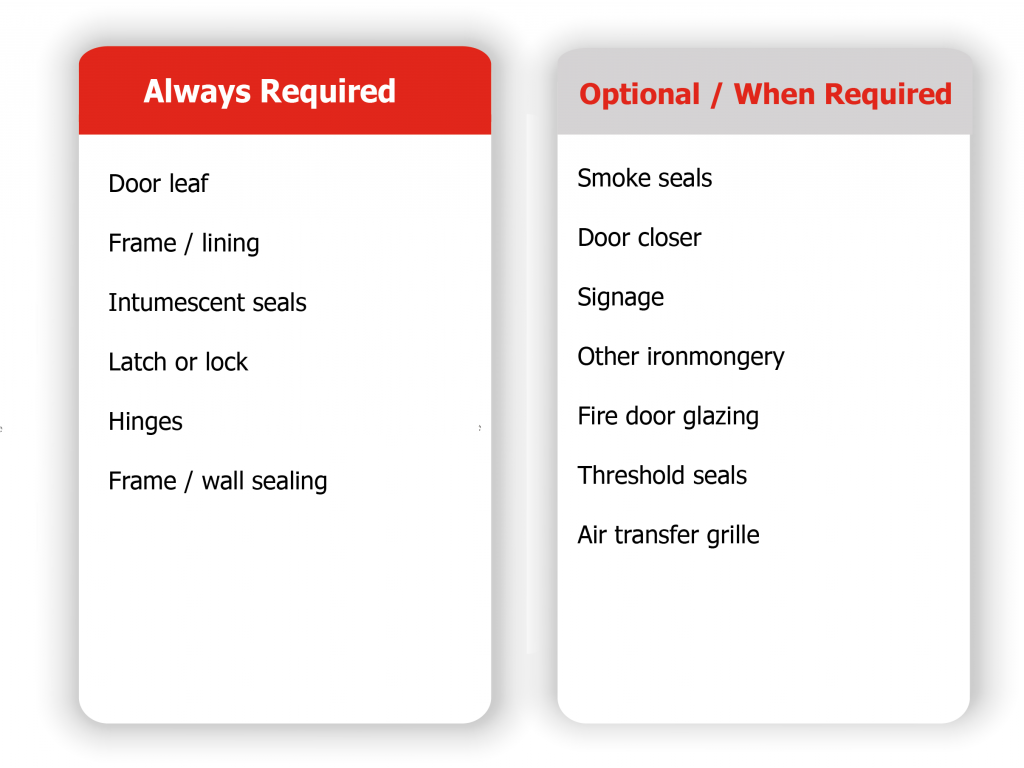What makes a fire door work? An exploration of the critical components

In everyday use a fire door is just as any other door. However, if a fire breaks out , the fire door, unlike any other door, must then perform its prime purpose – to protect lives and to prevent the passage of the fire to other parts of the building or to another building.
A fire door is not just a door. It’s a complete assembly comprising of the following components:

In the event of a fire, a fire door will not work unless all the right components have been fitted correctly and maintained.
Let’s dig a little deeper into these components…
Exploring the components
Door Leaf
The fire door leaf is the main component of the doorset or door assembly and is usually manufactured to a range of standard sizes and door styles. Fire doorset performance is demonstrated by the manufacturer’s test evidence, assessment reports or certification documents.
Frame/Lining or Casing
The frame’s design, size, fixings and material are critical to the fire performance and fire rating.
Intumescent seals
Intumescent seals can be located in the door edge or frame. They expand when heated by a fire and seal the gap between door and frame, stopping the passage of the fire. This gap is generally between 2 and 4mm but can be greater but only when supported by test evidence as larger gaps may prevent the intumescent seals performing correctly.
Smoke Seals
Smoke seals can be combined with intumescent seals or fitted separately. they are located in the perimeter of the frame or door edge. And can act as either wiper or compression seals to restrict the flow of smoke. Remember: Smoke Kills.
Fire door glazing
Some fire doors have vision panels fitted in them. Special fire tested glass and glazing systems must be used and the glazing process should only be undertaken by a trained and competent individual, with a good working knowledge of the specific materials and glazing systems required.
Threshold seals
Threshold seals are located on the bottom of the door or threshold, they seal the gap under the door to resist the flow of smoke and the passage of fire.
Signage
Correct fire door signage should be fitted at eye level on all non-domestic fire doors.
Hinges
A minimum of 3 fire rated hinges must be used, located correctly and fitted with using appropriate fixings and intumescent pads, when required.
Door closer
Some fire doors are fitted with closers to ensure the fire door always returns to its fully closed position and is held in the closed position when not in use.
Latch or lock
When fitted, the latch or lock engages the door leaf securely to the frame when the door is in the closed position. It is critical in securing the door in the event of a fire and preventing warping of the door.
Air transfer grilles
Fire rated air transfer grilles are fitted into some doors to keep fresh air circulating within a building, combining air movement with fire protection. In everyday use, air can pass freely through the grilles to allow good ventilation. In a fire, the intumescent expands, fusing the grille into a solid mass that stops fire spreading. Some fire rated Air Transfer Grilles combine fire with cold smoke protection, using an electro mechanical shutter plate system that closes when activated by the fire alarm , preventing the spread of deadly smoke and fumes. Fire only rated Air Transfer Grilles should not be used on doors designated as smoke control doors (e.g. FD30S and FD60S) in these doors, the combined fire and cold smoke dampers must be used.
Small differences in detail such as glazing apertures, intumescent seals, door frames and ironmongery may significantly affect the performance of the door. The results of changing the specification or not fitting the correct components could be catastrophic.
